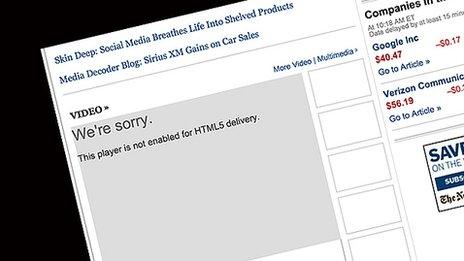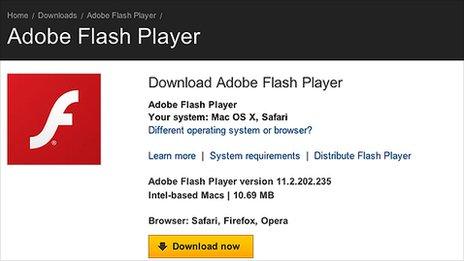Coding the future: HTML5 takes the internet by storm
- Published
The BBC's Ian Hardy looks at why companies have been rushing to embrace HTML5 - and the innovative ways it is being used
It's hard to imagine now, but original sites on the world wide web, written in HTML code or hypertext mark-up language, were made up of little more than text.
Corporate web designers were well aware that most of their customers had slow connections and would not tolerate much of a wait.
Even a simple black and white image could irritate a user, as it gradually appeared on the screen revealing itself one painful line at a time.
That began to change as modem speeds gradually crept up and content makers used more sophisticated methods to encode their multimedia content.
Macromedia's Flash, now an Adobe product, made all the difference when it arrived in the mid-nineties. Animations, video sequences and graphics became more sophisticated.
But since its invention in the early 1990s HTML has not supported video natively.
That is why HTML5 is being received so enthusiastically by businesses in particular. The latest version can perform all kinds of dynamic tasks and visual tricks. The web is progressing faster now than it has in a long time.
Going native
Application developers, like Kevin Sweeney who works at Vimeo, a video-sharing website based in New York, have already embraced the new tools that are built in to HTML5.

It will take time before all systems are able to work with HTML5
"We've needed to rely on third parties like Adobe Flash or QuickTime and had to embed this inside web pages. What HTML5 will do is remove them from the equation so this stuff is supported natively," he says.
Put simply it means that there's now much less chance that customers visiting a website will come across a black hole in the middle of the page, or get endless prompts to "download a plug-in" which may take several minutes to install.
By then it is often too late. The consumer has already clicked on a competitor's website.
The iPod Touch, iPhone and lately the iPad have been especially good at leaving black holes on the screen, because the former boss of Apple, Steve Jobs, would not allow Flash to run on any of his iOS devices from the start.
The success of these products globally means many companies cannot ignore the need to re-code their entire websites in HTML5, especially the multimedia content.
A lot of companies are not waiting for the HTML5 specs to be finalised and approved in a multi-year process. They have jumped right in, using early "unofficial" versions of the code to deliver a complete web page to every customer.
New horizons
Aaron Gustafson, author of the book Adaptive Web Design, says the versatility and dynamic nature of HTML5 means it can be used in new ways in different environments including the office and kitchen.
"We are starting to see devices that are not traditionally web devices becoming more web-enabled," he says.
"If you are a recipe curator with a website, all of a sudden you can build pages that work on a touchpad that's built into a refrigerator. People will know what ingredients they have in their refrigerator and keep track of it using an HTML5 app on the screen."

Many of Google's famous front page doodles, like this Jules Verne-inspired interactive submarine, are built using HTML5
Google is pushing HTML5 hard, not surprising since the greater impact that web pages and apps have, the more advertising it can sell.
Its search homepage is traditionally sparse but many of the doodles, including the Jules Verne-inspired interactive submarine, are now being designed to take advantage of the newest code.
Jeff Harris, product manager for Google Docs, says HTML5 will change the way its services operate from the ground up.
"A simple example would be taking an attachment from your desktop and dragging it into the compose window in Gmail. That's a basic capability that you couldn't do five years ago because web browsers didn't support it."
HTML5 also represents another step to the "semantic web", a web structure championed by Tim Berners-Lee that cross-references, reacts to and displays multiple information sources from the internet in real time.
HTML5 is partly responsible for the browser wars in the past few years.
A decade ago Chrome, Firefox and Safari didn't exist, and browser updates for Internet Explorer were only occasional.
Today desktop and mobile browsers update frequently as new HTML5 functions get incorporated.
Companies favour HTML5 because it can also replicate experiences previously only available inside an app, on the web. This is especially true for the mobile environment.
And a lot of brand names don't like being part of someone else's ecosystem because they lose control of pricing and subscribers. The Financial Times recently announced it will shut off its iPad app completely following the success of its HTML5 web page.
This is a trend that is likely to snowball within months.
Flash forward
But where does this leave Adobe Flash?

Adobe's Danny Winokur insists Flash still has a future
The company has already stopped supporting it on mobile devices.
Danny Winokur, the general manager of the Interactive Development Business at Adobe, says the future of Flash is not in doubt, especially since protecting high quality assets with DRM (Digital Rights Management) is not yet possible in HTML5.
"Flash is allowing things like 3D immersive gaming that you would normally see on an Xbox or Playstation to come into a web browser," he says.
"That's something that HTML may eventually be able to do but it has a long way to go. Flash will pioneer those most advanced cases like HD feature-rich cinema graphic content that needs to be copy-protected."
Ideally of course the end user will not notice, or even care, that the web is being powered by a new updated set of code.
If HTML5 does its job properly, no-one outside the web development community will ever know about it!